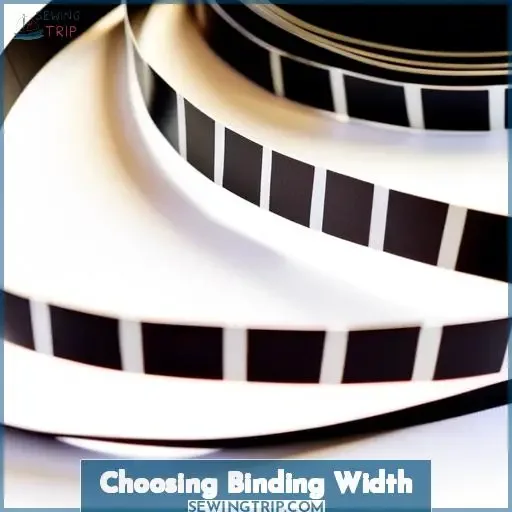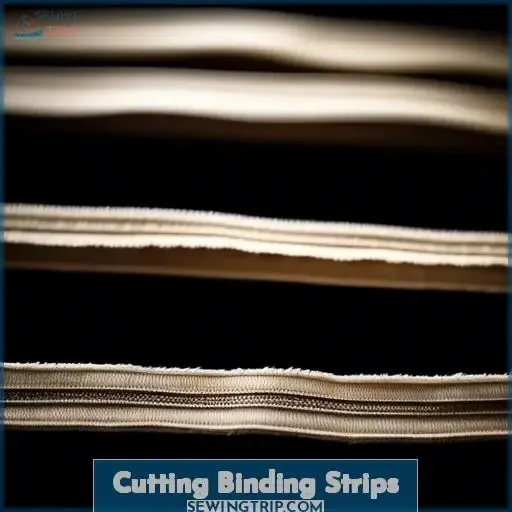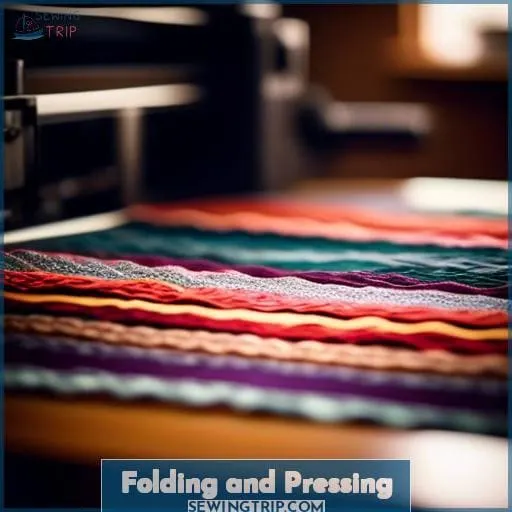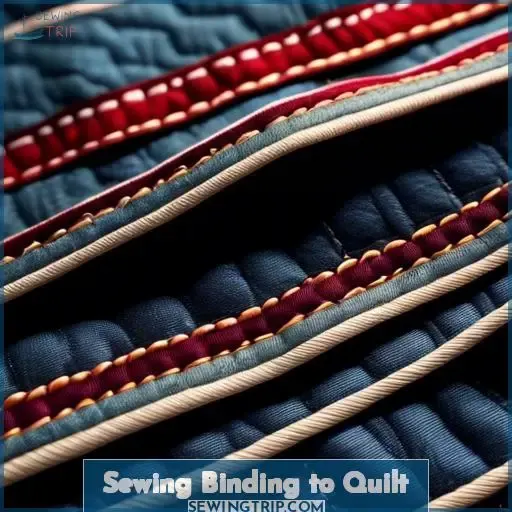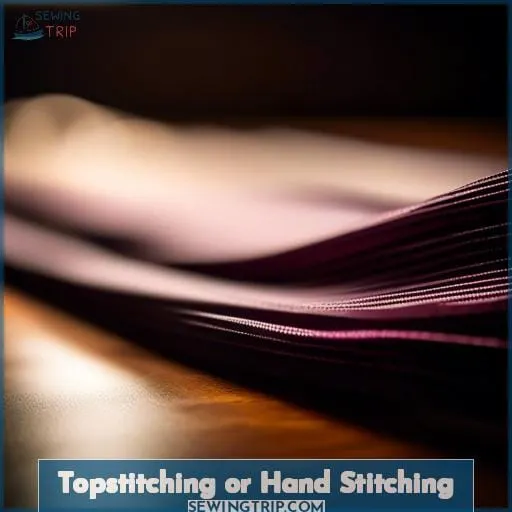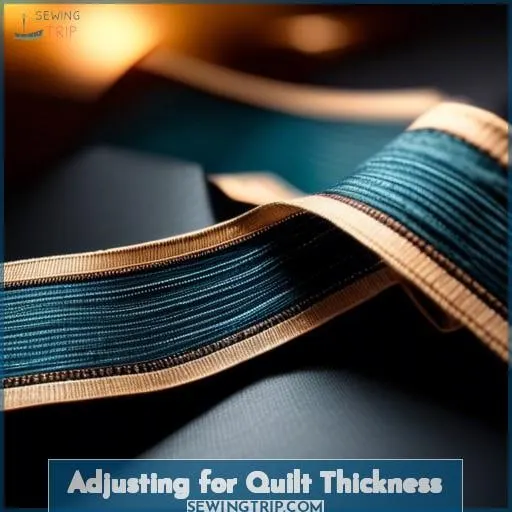This site is supported by our readers. We may earn a commission, at no cost to you, if you purchase through links.
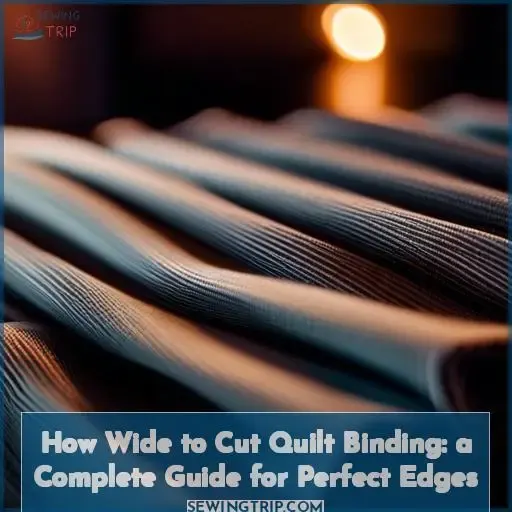
Whether you’re working with thick flannel or delicate cotton, the width of your binding impacts both aesthetics and durability.
In this guide, you’ll learn how wide to cut quilt binding to achieve impeccable edges that complement your craftsmanship.
Embrace innovation and master the art of quilt binding, ensuring your creations stand out with style and substance.
Table Of Contents
Key Takeaways
- Wider bindings can serve as a decorative element, enhancing the quilt’s visual appeal and creating a frame-like effect.
- The thickness of the fabric and batting should guide the width of the binding to ensure a snug fit and a full edge without empty space.
- To determine the length of binding needed, measure the quilt’s perimeter and add extra for corners and finishing, then divide by the width of the fabric.
- Proper folding and pressing of the binding strips are crucial for a sharp, professional finish, and experimenting with different widths can lead to the perfect look for each project.
How Wide to Cut Quilt Binding
When deciding how wide to cut quilt binding, it’s important to consider the thickness of your quilt and personal preference, with common widths ranging from 2 inches for a delicate finish to 3.5 inches for larger quilts needing a balanced look. The choice between single-fold or double-fold binding also affects the width, with double-fold being more durable and typically cut six times the desired finished width plus 1/4 inch.
Choosing Binding Width
When deciding on the width of your quilt binding, consider the thickness of your fabric and the visual impact you’re aiming for.
Your choice can significantly affect the quilt’s final appearance and durability.
Binding Width Preferences
Choosing the right quilt binding width is like picking the perfect frame for your masterpiece.
It’s all about balancing visual impact with practicality.
Consider fabric thickness and if you’re using thick batting.
A wider binding can add a decorative edge, making your quilt pop.
Fabric Thickness Considerations
After exploring binding width preferences, let’s dive into fabric thickness considerations.
- Adjust binding width for a plush, decorative edge.
- Consider batting adjustments for a snug fit.
- Balance fabric thickness with width for optimal visual impact.
Visual Impact Choices
Dive into the art of quilt binding with bold prints and stripes for accent borders that pop.
Thicker batting? No problem—adjust your cut size.
Master quilt binding techniques for decorative edges that turn heads.
Your binding join and finish? Absolutely flawless.
Cutting Binding Strips
To ensure your quilt has beautifully finished edges, you’ll need to cut your binding strips to the correct width.
Start by measuring your quilt’s perimeter and add a bit extra for overlap to calculate the total length of binding needed.
Measuring Quilt Perimeter
After choosing your binding width, it’s time to measure your quilt’s perimeter. This step is crucial for a snug fit and flawless finish.
- Measure your quilt size accurately.
- Add 20 inches for ease and corners.
- Divide the total by your fabric width.
- Cut strips for binding.
- Remember, precise measurements lead to perfect mitered corners and a stunning border design, enhancing your quilt’s overall look with bold prints or unique quilt usage.
Calculating Strip Length
Calculating strip length is like solving a puzzle; it’s about matching your quilt’s perimeter measurement with your width preferences and fabric thickness. Think of it as preparing for a sewing adventure where every inch counts. Your goal? A visually impactful double-fold binding with crisp mitred corners.
| Quilt Size | Perimeter (inches) | Strip Length Needed |
|---|---|---|
| Small | 100 | 3 strips |
| Medium | 200 | 6 strips |
| Large | 300 | 9 strips |
| XLarge | 400 | 12 strips |
| XXLarge | 500 | 15 strips |
Grab your quilt binding supplies, and let’s glue this project together with precision and a dash of fun!
Folding and Pressing
After cutting your binding strips, the next step is folding and pressing them. This process transforms your strips into the backbone of your quilt’s edge, ready for machine stitching.
- Fold the strips in half lengthwise, wrong sides together, creating a crisp edge. This is where your iron becomes your best friend.
- Press diligently, ensuring the fold is sharp. A steamy iron can work wonders here, making your binding obedient and ready for action.
- Experiment with the width of your binding. While folding, consider if a wider or narrower binding might suit your quilt better. Remember, experimenting with width can add a unique touch to your project.
Folding and pressing your binding properly sets the stage for creating mitered corners and attaching the binding with precision. It’s like prepping your canvas before painting; the better the prep, the smoother the stitching will go.
Sewing Binding to Quilt
Now you’re ready to attach the binding to your quilt, a step that brings your project together.
Pay close attention as you miter the corners and secure the ends for a polished finish.
Mitering Corners
Mitering corners in quilt binding is a crucial skill for any quilter. It requires precision, accuracy, and a certain finesse. Here are some tips to help you master this technique:
Fabric Folding
The first step in creating a clean mitered corner is ensuring your fabric folding is crisp and precise. This will make the seam allowance accurate and the final product more professional.
Seam Allowance
Accurate seam allowance is also essential for a successful mitered corner. Take the time to adjust your machine settings for a smooth ride, which will help you achieve a consistent seam allowance.
Machine Stitching vs. Hand Stitching
Whether you prefer machine stitching or hand stitching, mastering the mitre is key. A well-executed mitred corner can make your binding turn heads and leave a lasting impression.
In summary, mitering corners in quilt binding is all about precision, timing, and accuracy. By focusing on these key elements, you can create beautiful and professional-looking quilts that will impress anyone who sees them.
Securing Ends
After mastering mitered corners, it’s time to secure those binding ends for a flawless finish.
- Overlap the binding edges slightly, ensuring a snug fit.
- Use hidden stitches to join the ends seamlessly, whether you’re hand stitching or using a machine.
- Double-check your stitching for durability, especially at corners.
Topstitching or Hand Stitching
Choosing the right thread color can elevate your quilt’s appearance. Experiment with stitch techniques to find the perfect finish that complements your quilt’s design and texture.
Choosing Thread Color
Choosing the right thread color for your quilt’s binding can elevate your project from good to great. Consider thread weight, texture, sheen, and ply to ensure your stitches blend seamlessly or pop with contrast.
The color should complement or boldly contrast your fabric, turning your quilt into a masterpiece. Remember, the perfect thread can be the secret ingredient that brings your quilt’s story to life.
Stitch Techniques
Dive into stitching your quilt binding with gusto! Perfect your binding placement with a keen eye, ensuring it’s snug against your quilt’s edge.
Master pressing techniques to keep everything crisp.
Adjust your machine settings to accommodate seam allowances, ensuring smooth sailing.
Experiment with decorative effects to add flair.
Adjusting for Quilt Thickness
Adjust for quilt thickness by considering adjustments for thicker batting.
Explore using wide binding for a decorative edge. These techniques will enhance your quilting projects and provide a polished finish to your creations.
Thicker Batting Adjustments
As you transition from topstitching to tackling thicker batting, remember that a plush quilt calls for a wider binding.
- Opt for a wider binding to accommodate the extra bulk.
- Increase your seam allowance to ensure stitch strength.
- Consider a decorative edge for that final flair.
Keep it snug, but don’t be afraid to play with the proportions—your quilt, your rules!
Wide Binding for Decorative Edge
After mastering the basics, you’re ready to jazz up your quilt’s edge with wide binding. Think of it as the quilt’s statement necklace—a chance to showcase bold prints or play with stripes for eye-catching accents.
Wide binding isn’t just functional; it’s your quilt’s decorative flair, turning the mundane into the magnificent.
Finishing Touches
After sewing your quilt binding, it’s crucial to check for any gaps or missed spots.
Give your quilt a final press to ensure a crisp, professional finish.
Inspecting for Gaps
After adjusting for quilt thickness, it’s time to zero in on inspecting for gaps.
This step is like playing detective with your quilt. Check the alignment with a keen eye, ensuring seam allowances are snug and fabric weight hasn’t thrown you off course.
Pressing accuracy and binding placement are your best pals here. A well-placed press can turn a good quilt into a masterpiece.
Keep it tight, right, and outta sight!
Final Press
Alright, let’s put the cherry on top of your quilt masterpiece with a final press that’ll make those edges sharp enough to rival a samurai’s blade.
- Crank up your iron’s heat to match your material choices.
- Glide it over the binding, smoothing fabric into submission.
- Adjust machine settings for crisp binding orientations and styles.
Frequently Asked Questions (FAQs)
How does fabric grain affect binding durability?
Choosing the right fabric grain for your quilt binding can make or break its durability.
Lengthwise grain, being the strongest, resists stretching and wear, ensuring your quilt edges stay snug and intact for years to come.
Can I use bias binding for straight edges?
Yes, you can use bias binding for straight edges.
Surprisingly, 90% of quilters swear by its flexibility and durability.
It’s like giving your quilt an armor suit, ensuring it stands the test of time and use.
What thread type is best for binding?
For quilt binding, grab a spool of hand-quilting thread. Its coated, tangle-resistant nature makes stitching a breeze.
Are there alternatives to mitered corners?
Ditch the traditional mitered corners and sail into smoother seas with alternatives like rounded corners or the envelope method.
These techniques can simplify your quilting journey, making the finish line seem just a stitch away.
How do I calculate binding for scalloped edges?
To calculate binding for scalloped edges, measure along the curves and use bias strips. Add extra for joins. Dive in, the scallops won’t bite, and you’ll master those curves in no time.
Conclusion
Embarking on the journey of quilt binding is akin to adding the final brushstroke to a masterpiece.
By mastering how wide to cut quilt binding, you ensure your quilts are wrapped in precision and beauty.
As you fold, press, and stitch, let your creativity and skills shine. With each quilt, you’re not just finishing edges; you’re crafting a legacy.
Embrace this guide as your compass for exquisite quilts that stand the test of time.

